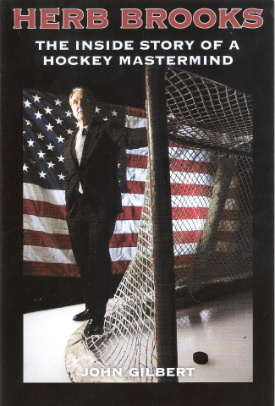Legacy of Herb Brooks Lives On
Herb Brooks passed away at the age of 66 on August 11, 2003 after an automobile accident. Although gone, Brooks and his tremendous impact on hockey – especially American hockey – will never be forgotten.
To many, Brooks is remembered for coaching the 1980 USA Olympic hockey team to a stunning upset of the Soviet Union and winning the gold medal against Finland. In “Herb Brooks: The Inside Story of a Hockey Mastermind”, John Gilbert (author and close friend of Brooks) provides us with a closer look at Brooks as a player, coach and human being than anybody else had done before in books or films.
“The most complete and personal account on the most compelling person in U.S. hockey history. John Gilbert intimately dissects Herb Brooks’ DNA to tell a human story that is complex and interesting. This is a wonderful book.”
— John Buccigross, ESPN
Gilbert does an excellent job of showing Brooks’ strong will and character. Brooks was a man of principle and vehemently stood for what he believed in.

Herb Brooks won three NCAA titles with the Minnesota Gophers, led USA to the gold medal in the 1980 Olympics and silver medal in the 2002 Olympics. Brooks was very outspoken about the development of American hockey players.
Brooks believed in the American hockey player; furthermore, he believed the American hockey player could excel in hockey as well as Canadians and Europeans if given the opportunity to shine.
When coaching in the NCAA, Brooks recruited only American players while many NCAA coaches recruited Canadians who were overage and no longer eligible for Canadian Juniors leagues.
Brooks turned the Minnesota Gophers into a powerhouse as he won three national championships and demonstrated what possibilities may come from developing American players.
Brooks was unafraid to question conventional thinking. Brooks thought outside the box and patterned his beliefs on hockey systems after those of legendary Soviet coach Anatoli Tarasov. Although Brooks patterned his beliefs on Tarasov’s beliefs, he did not entirely copy Tarasov’s system. Brooks was an innovator ahead of his time who created a hybrid style of hockey for Americans which incorporated the Canadian rock-solid defensive discipline and the free-flowing run-and-gun creativity of European teams.
Although NHL teams today generally still do not implement Brooks’ philosophies on hockey, that may soon change. With the NHL’s crackdown on obstruction, more emphasis will likely be placed upon Brooks’ ideas of puck possession, speed, creativity and flow over the next few years. I find it ironic when Canadians scoff at hybrid and/or European styles of play. Canada’s most beloeved hockey hero – Wayne Gretzky – played the Soviet style of hockey.
It is unfair for Brooks to be remembered by anyone solely for the “miracle on ice” at Lake Placid in 1980. Gilbert provides us with a wonderful in-depth look at the success Brooks had in coaching on the NCAA, Olympic and NHL levels of hockey. Gilbert also shows the lighter side of Brooks, as former players speak of how greatly they loved and respected their coach. Although Brooks sometimes came off as a gruff whip-wielding taskmaster, he was able to motivate his players and get 100% effort out of them.
Gilbert’s passion for hockey is evident in this book, as is his respect and admiration for Brooks. Gilbert is passionate about hockey, is a close friend of the Brooks family and he gives credit where credit is due. This is a must-read for all hockey fans, especially American hockey fans.
Christopher Wenrich can be reached at philliesmuse@yahoosports.com.